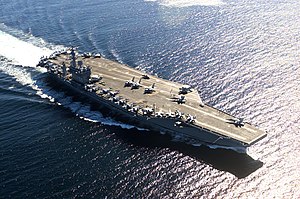
Back حاملات الطائرات فئة نيمتز Arabic নিমিৎজ-শ্রেণি বিমানবাহী রণতরী Bengali/Bangla Třída Nimitz Czech Nimitz-klassen Danish Nimitz-Klasse German Clase Nimitz Spanish ناو هواپیمابر رده نیمیتز Persian Nimitz-luokka Finnish Classe Nimitz French נושאות המטוסים מסדרת נימיץ HE
 USS Nimitz (CVN-68), lead ship of the class of supercarriers, at sea near Victoria, British Columbia, after the 1999–2001 refit
| |
| Class overview | |
|---|---|
| Name | Nimitz-class aircraft carrier |
| Builders | Newport News Shipbuilding Company |
| Operators | |
| Preceded by | |
| Succeeded by | Gerald R. Ford class |
| Subclasses | |
| Cost | US$1.98 billion in 1975[1] ($11.2 billion in 2023)[2] |
| Built | 1968–2006 |
| In service | 1975–present |
| In commission | 3 May 1975 |
| Planned | 10 |
| Completed | 10 |
| Active | 10 |
| General characteristics | |
| Type | Aircraft carrier |
| Displacement | 100,000 to 104,600 long tons (101,600–106,300 t) full load[3] |
| Length |
|
| Beam |
|
| Draft |
|
| Propulsion |
|
| Speed | 30+ knots (56+ km/h; 35+ mph)[6] |
| Range | Unlimited distance; 20–25 years |
| Complement |
|
| Crew | 5,000–5,200[1] (including airwing) |
| Sensors and processing systems |
|
| Electronic warfare & decoys |
|
| Armament |
|
| Armor | 2.5 in (64 mm) Kevlar over vital spaces[7] |
| Aircraft carried | 85–90 fixed wing and helicopters[6] |
The Nimitz class is a class of ten nuclear-powered aircraft carriers in service with the United States Navy. The lead ship of the class is named after World War II United States Pacific Fleet commander Fleet Admiral Chester W. Nimitz, who was the last living U.S. Navy officer to hold the rank. With an overall length of 1,092 ft (333 m) and a full-load displacement of over 100,000 long tons (100,000 t),[3] the Nimitz-class ships were the largest warships built and in service until USS Gerald R. Ford entered the fleet in 2017.[8]
Instead of the gas turbines or diesel–electric systems used for propulsion on many modern warships, the carriers use two A4W pressurized water reactors. The reactors produce steam to drive steam turbines which drive four propeller shafts and can produce a maximum speed of over 30 knots (56 km/h; 35 mph) and a maximum power of around 260,000 shaft horsepower (190 MW). As a result of nuclear power, the ships are capable of operating for over 20 years without refueling and are predicted to have a service life of over 50 years. They are categorized as nuclear-powered aircraft carriers and are numbered with consecutive hull numbers from CVN-68 to CVN-77.[Note 1]
All ten carriers were constructed by Newport News Shipbuilding Company in Virginia. USS Nimitz, the lead ship of the class, was commissioned on 3 May 1975, and USS George H.W. Bush, the tenth and last of the class, was commissioned on 10 January 2009. Since the 1970s, Nimitz-class carriers have participated in many conflicts and operations across the world, including Operation Eagle Claw in Iran, the Gulf War, and more recently in Iraq and Afghanistan.
The angled flight decks of the carriers use a CATOBAR arrangement to operate aircraft, with steam catapults and arrestor wires for launch and recovery. As well as speeding up flight deck operations, this allows for a much wider variety of aircraft than with the STOVL arrangement used on smaller carriers. An embarked carrier air wing comprising around 64 aircraft is normally deployed on board. The air wings' strike fighters are primarily F/A-18E and F/A-18F Super Hornets. In addition to their aircraft, the vessels carry short-range defensive weaponry for anti-aircraft warfare and missile defense.
The unit cost was about US$8.5 billion in FY 2012 dollars,[1] equal to US$11.2 billion in 2023.[2]
- ^ a b Johnston, Louis; Williamson, Samuel H. (2023). "What Was the U.S. GDP Then?". MeasuringWorth. Retrieved 30 November 2023. United States Gross Domestic Product deflator figures follow the MeasuringWorth series.
- ^ a b Polmar 2004, p. 112
- ^ Kuperman, Alan; von Hippel, Frank (10 April 2020). "US Study of Reactor and Fuel Types to Enable Naval Reactors to Shift from HEU Fuel". International Panel on Fissile Materials. Archived from the original on 5 October 2021. Retrieved 26 February 2022.
- ^ Hanlon, Brendan Patrick (19 May 2015). Validation of the Use of Low Enriched Uranium as a Replacement for Highly Enriched Uranium in US Submarine Reactors (PDF) (MSc). Massachusetts Institute of Technology. Archived (PDF) from the original on 9 October 2021. Retrieved 26 February 2022.
- ^ a b Gibbons, Tony (2001). The Encyclopedia of Ships. London, United Kingdom: Amber Books. p. 444. ISBN 978-1-905704-43-9.
- ^ Fontenoy, Paul E. (2006). Aircraft carriers: an illustrated history of their impact. ABC-CLIO Ltd. p. 349. ISBN 978-1-85109-573-5.
- ^ "25 Largest Warships In History". Science & Technology. 5 April 2017. Archived from the original on 12 April 2018. Retrieved 11 April 2018.
Cite error: There are <ref group=Note> tags on this page, but the references will not show without a {{reflist|group=Note}} template (see the help page).